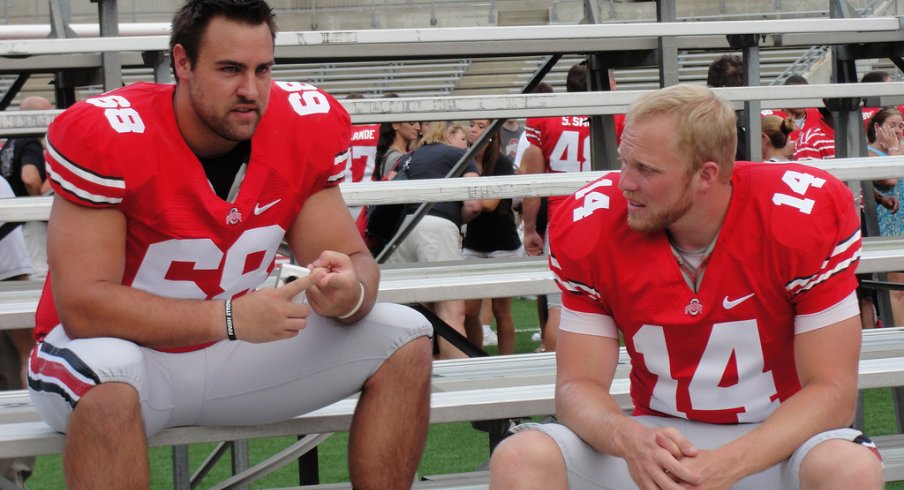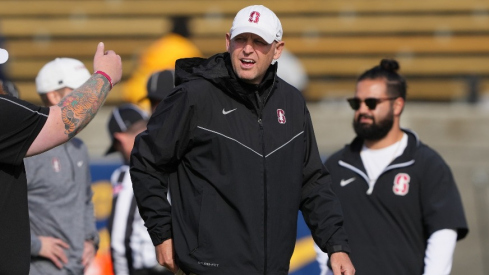Ohio State lands the nation's No. 1 safety in the 2026 class as Blaine Bradford commits to the Buckeyes.
Urban Meyer has taken a lot of the drama out of following Ohio State recruiting. Aside from the fact that his classes have been almost universally lauded, they also tend to commit early and stay that way. He's also been adept at turning the entire concept of "recruiting" on its head; through some pretty clever salesmanship, he's been able to convince more than a handful of blue chip players that they need Ohio State way more than it needs them. Those players then go on to extoll the virtues of being a Buckeye to others, and so on until you end up with a top five recruiting class in every year but one since Urban took over.
It wasn't always that way. Not that I'm trying to portray Jim Tressel as a hat-in-hand Willie Loman type, shoulders bent as he limply trudged from one house to the next, asking teenagers to play football for him (that's Darrell Hazell's niche, thank you very much). Tressel was generally a very good recruiter who managed to put together a number of very impressive and successful recruiting classes, but also had more than his fair share of really baffling years where it seemed like the Ohio State coaching staff decided to bring on some hilariously marginal players, almost for the hell of it.
That's a joke, obviously. For all of his folksy mannerisms and intentionally bland demeanor, Tressel was every bit a competitor that Urban is. Which is why his 2004 Ohio State recruiting class is a wonder, in the sense that it's like if Da Vinci got three fourths of the way finished with the Mona Lisa, and then decided to finish it up drunk and blindfolded with crayons.
Ted Ginn, Jr., Vernon Gholston, Antonio Pittman, Marcus Freeman, and Rory Nicol would go on to have college careers that varied between "decent" and "HOLY CRAP TED GINN JUST MELTED MY FACE," but five two star players joined them, and one in particular remains synonymous with being in way over your head to this very day.
Point is, the absolute best time to look back at one of the weirdest recruiting failures in the last decade plus is when we're having the most success. It's important to acknowledge how lucky we as Ohio State fans are, and to drive that point home, we're going to talk a lot about two-star 2004 Ohio State recruits Dionte Johnson, Curtis Terry, Dennis Kennedy, Brandon Smith, and of course, Joe Bauserman.
Dionte Johnson
Dionte had a serviceable career as a fullback at Ohio State, but maybe somewhat predictably never made much of an impact beyond that. He had a short stint in the NFL, but when that fizzled out, he started the second phase of his life in a surprising way: fashion.
“I always knew I wanted to retire and open a boutique to have something to do,” he said. “I thought I’d have one at (age) 50 or something like that, but it came fast.”
In 2010, Johnson bought Sole Classics on N. High Street — best-known for its athletic shoes.
Curtis Terry
Curtis Terry's career at Ohio State is marked by injuries, halting progress, and starts and re-starts. In 2004 and 2005, Terry was a decent special teams player who looked like he might make an impact at linebacker as an upperclassman, but after seeing a decent amount of action in 2006, injuries stunted his playing time and he eventually finished playing at Ohio State in 2008.
Dennis Kennedy
Kennedy signed with Ohio State but was never able to meet the required academic standards, and ended up playing at Akron.
Brandon Smith
Another special teamer, Brandon Smith was a kind of jack-of-all-trades who contributed on offense and defense, but was primarily seen as a fullback. He's a player who filled a role ably and consistency, and has the quintessential two-star career.
Joe Bauserman
I don't need to recap Bauserman's career at Ohio State for anyone reading this blog, but it is important to note two things: first, Bauserman wasn't a total unknown. Scout only gave him two stars, but Rivals gave him three, and he was a semi-legit baseball prospect (which is why his arrival on campus was delayed several years). Secondly, Bauserman was quarterback at an extremely difficult time at Ohio State, and was really never supposed to be a starter.
But in a larger sense, Bauserman represents many of the failings of Jim Tressel's recruiting in that Tressel often focused on two or three "stars" that would carry the water for the rest of the team, while he coached up everyone else. That worked because Jim Tressel was a witch who could micromanage an anthill into becoming the Petronas Towers, but absent his influence, it falls apart.
Truthfully, it's more than a little unfair to single out these five guys as emblematic of Ohio State recruiting failures. Tressel and company assembled several classes that looked pretty underwhelming on paper, including a 2010 class ranked 20th in the country.
It's also probably more than a little unfair to pretend that Tressel didn't know what he was doing when he picked up these guys. The 2010 class, for example, included Carlos Hyde, Andrew Norwell, Christian Bryant, and three stars John Hankins and Bradley Roby. The Senator was adept at finding players that were often overlooked and underappreciated and turning them into stars.
That is not the Urban Meyer M.O. He is much more inclined to look for the best and get the best, albeit with somewhat more selectivity than he had at Florida. Still, the percentage of Ohio recruits in Buckeye recruiting classes has been trending downward since Meyer took over, and maybe most telling, Meyer has brought in one (1) two-star recruit since 2011.
It's a different attitude and a different recruiting regime, and as beloved as Jim Tressel still is at Ohio State, I highly doubt that many Buckeye fans want to go back to the time when they were crossing their fingers for a top 15 recruiting class. But it also carries with it increasingly large expectations, because while we enjoyed being amazed as three-star James Laurinaitis became a household name nationally, we now expect the same from five-star recruits like Tate Martell.
That's an expectation that Meyer and company have embraced, but with it comes a pressure that is never going to diminish, especially as fans think back to a coach who accomplished so much with less.


